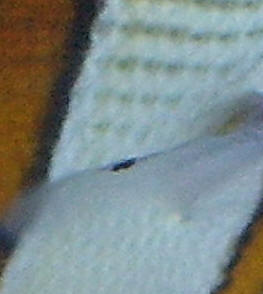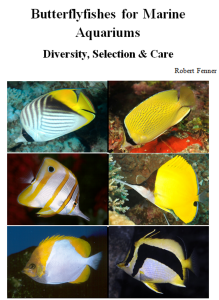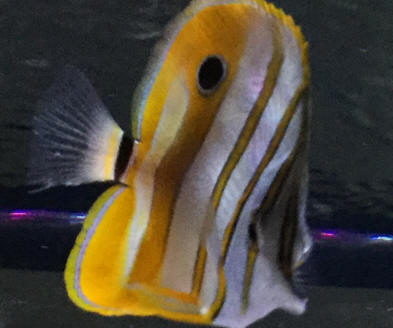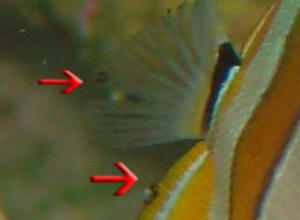|
FAQs on Chelmon
Butterflyfishes Disease Diagnosis
FAQs on Chelmon Disease:
Chelmon
Disease 1, Chelmon
Disease 2,
Chelmon Disease 3,
Chelmon Disease 4,
FAQs on Chelmon Disease by
Category:
Diagnosis,
Environmental,
Nutritional,
Trauma,
Infectious, Parasitic,
Social,
Treatments
FAQs on Butterflyfish Disease:
Butterflyfish
Disease 1,
Butterflyfish Disease 2,
Angels and Butterflyfishes &
Crypt,
FAQs on Butterflyfish Disease by
Category:
Environmental,
Nutritional,
Social,
Trauma,
Infectious,
Parasitic,
Treatments
Related Articles: Chelmon Butterflyfishes, Foods/Feeding/Nutrition,
Related FAQs: Chelmon Butterflies 1, Chelmon Butterflies 2, Chelmon Identification, Chelmon Behavior, Chelmon Compatibility, Chelmon Selection, Chelmon Systems, Chelmon Feeding, Foods/Feeding/Nutrition,
Using Chelmons as Aiptasia Controls, Butterflyfish Identification, Butterflyfish
Foods/Feeding/Nutrition, Butterflyfish
Compatibility,
Butterflyfish Behavior,
Butterflyfish Systems, Butterflyfish Selection, Butterflyfish Disease,
Butterflyfish
Reproduction,
|

|
 |
Butterflyfishes for Marine Aquariums
Diversity, Selection & Care
New eBook on Amazon: Available
here
New Print Book on Create Space: Available
here
by Robert (Bob) Fenner |
Copper Banded Butterfly changing appearance...
4/20/20
Hi gang,
<Hey Chuck>
I have kept a copper banded butterfly for 3+ years in my macroalgae
display tank (connected via common sump with my reef tank)
<Chelmon rostratus is not one of the easiest BF species to keep; it
requires top water quality and a varied diet.>
... it's a low intensity tank, with just a juvenile scopas tang for
company.
<What are your water parameters?>
He feeds almost exclusively on frozen Mysis, and whatever else he gleans
from the seaweed.
<This diet is not varied enough.>
Recently, the gold vertical stripe underneath the 'false eye' near the
tail has started going dark... almost black. It's symmetrical on both
sides of the fish. No signs of trauma... appears to be a pigmentation
issue. Is this a sign of stress... or advancing age... or anything else
you can think of?
<Not because of advanced age, no... these fish can live up to 20 years.
I think this is more environmentally stress related.>
Thanks in advance for any help on this...
Blessings,
Chuck
<Cheers. Wil.>
|
Copperbanded Butterfly with new spots
11/21/17
Hello. Love your guys site. Was hoping you could help me ID this disease.
<... 9 megs of uncropped pix John!? Looks to me to be Crypt-like.
VERY common w/ imported Chelmons... s/b pH adjusted freshwater dipped/bathed
enroute to quarantine for a couple weeks...>
Got this Copperbanded 3 weeks ago and he spent a week in QT.
<Need at least two>
Is eating bloodworms very aggressively and looks otherwise healthy.
<Ahh! Good signs>
Overnight he developed so damage to his caudal fin and now it has a
single white spot on it.
<Only the one? Might be naught/nothing... a pinch w/ accumulated mucus.
I would NOT treat>
He has no other spots or damage to fins. I’m hoping it’s lymph and plan to leave
him be and not stress him by throwing him back in QT. Doing a water Change today
as it is that time of month. Info on the tank he is in it is a
75 with a 30 gal sump and has been running for more then a year. All tank mates
look healthy (2 O. Clowns and a Flame angel, one first shrimp, one cleaner
shrimp). Thanks for any advice.
John
<Do stay vigilant.. i.e., keep an eye on this fish. Have a read on WWM re
Protozoans of marine fishes.
Bob Fenner>
|
 |
Copper Band Butterfly looking dirty
3/6/12
Hello, this is my first time asking a question on WWM. I looked
everywhere to find some information about my new copper band butterfly’s
symptom but couldn’t find any so I’m asking for help. My CBB is
eating only frozen blood worms right now,
<Very important to widen this diet... Read here:
http://www.wetwebmedia.com/chelmonfdgfaq.htm
and, why not? The linked files above>
was eating reef caviar and Mysis when I first brought him home but I
guess he’s favoring bloodworms.
<... please search on WWM re these sewer worm larvae... implicated in
disease>
Anyways, I started noticing some discoloration on his body, they
are patches of them and his overall color looks dirty, like black dust
have covered him up or something. I can still see his white and
yellow bands but somewhat faded. His fins look clean and eating
really well. For the most part, I think he’s acting normal,
picking at rocks occasionally. I have a small yellow tang and a
blue hippo tang that pick on him occasionally but he’s getting used to
it. I was wondering what this dirty looking Copperband
might be dealing with.
<... could be just nutritional, social... some aspect of water quality.
Not normal or healthy though>
I just started soaking the blood worms on Zoecon to help with his immune
system but it’s been only a few days. Thank you in advance!
<Keep reading. Bob Fenner>
| Spot on Copperband ID Help?
4/7/08 Hello I have searched the WWM site and still
cannot find what I am looking for. I have a Copperband
Butterfly that has something attached to it's fins. I
included a picture to see if you could tell me what it might
be and how to treat it. Thanks. Brian <Mmm, I strongly err
on the side of caution here... and say these are not likely
pathogenic, but some sort of residual tissue from some type
of damage. If anything I might try adding a purposeful
cleaner here (Likely a genus Lysmata shrimp)... and leave
these to it. Bob Fenner> |
|

|
|
Unknown Fish Disease? Chelmon spots 11/12/07 Hello
there, Love the site it saved my sick sand sifting star
fish (he's now in a MUCH MUCH bigger home) not to
mention research here prevented me from buying a horse shoe
crab my LFS was trying to push on me. Hopefully you can
help me with my most recent problem for starters I'll
run my tank info at ya. 50 Gallon Tank about 4 months
running Remora C Protein hang on Skimmer 2 Hydor Koralia
Pumps #3 850gph each 1.5" Dolomite bottom <Mmm, do
replace this in time> 2" live sand bed on top of
the dolomite would this be considered a plenum of sorts?
<Of a sorts... but do you have the defined
"gap" water space alone underneath?> probably
40 or 50 lbs of live rock good coralline coverage on pumps
and back wall Water parameters: last tested 10/26 at LFS
<I'd get your own kits... water chemistry changes
with movement, time...> Ph 8.1 Ammonia 0 nitrite 0
nitrate 10 (was told this might be due to a 350 magnum
canister filter that I have removed from the system) KH 9
Calcium 450 Salinity 1.023 Live Stock: 10 Blue leg hermit
Crabs 6 Red Leg hermit crabs 3 zebra striped Astrea snails
1 turbo snail 1 gold ring cowry 1 queen fighting conch 1
Pencil Urchin 1 Cleaner Shrimp 1 long tentacle Anemone 1
anemone crab 2 emerald crabs 1 brittle starfish brown
How's the cleaning crew look? light heavy? <A mix...
I'd keep your eye on the Mithraculus> 1" colony
of star polyps 1" colony of Zoanthids 1" Florida
Ricordea Fish: 1 green mandarin (he eats live brine, frozen
Mysis, and chilled Arctipods along with the live pods on my
LR) My current worry is my only other fish a Copper band
butterfly <Hard to keep in small tanks like this> he
has 3 black spots on the very edge of his pectoral fin and
one black spot on the farthest back edge of his dorsal fin
I've searched your site for black spots but all I can
find is black Ich these spots are about the size of #2
pencil lead seemingly MUCH larger than the pictures of
black Ich I've found they haven't spread or moved
but just hold on. He hasn't shown any signs of rubbing
against anything or discomfort he's still eating an lot
of Mysis shrimp he never ignores it so I just feed him a
few minutes worth and leave it at that. <I would... do
nothing overt here... The spots could be "just
coloring"... melanism from?...> He won't stay
still long enough for my cleaner to go near him I don't
think it's a lazy cleaner because it loves to pick at
my fingers. I'm nervous that these black spots have the
potential to spread to my mandarin I haven't set up a
QT tank yet Any ideas what these might be? Please help
<Not likely at all to be a spreading problem> I'm
also considering in the future a black false percula clown
and a flame angel I don't want to overload the system
though does it sound ok to you? Thanks, Very nervous
<Don't be... Do start planning re where you're
going to put the new, larger system... You've got the
bug, not the Chelmon. Cheers, Bob Fenner>
Re: Unknown Fish Disease? Chelmon
spots 11/14/07 Hello again! I
didn't properly proof read my E-mail and there was a
miscommunication here on the Copper band spots. I'm
terribly sorry... They aren't really spots but have the
size of small black ants attached to the fins. <I see
them...> 3 on the pectoral and one on the tip of the
dorsal I've enclosed two pictures hopefully they're
high enough quality and yet small enough to meet your
standards. <Yes... good images... Don't appear to be
"organismal"...> here are some interesting
bits of info that might or might not help. The fish seems
to have a very minor case of Ich on the fins that do not
have these black things on them but no sign of white spots
on the pectoral that has them. I can't seem to get a
closer shot then the one I'm sending you and they have
shown no signs of movement it might be my imagination but
it seems like one has actually "fragged itself"
with 3 tiny spots next to it that I did not notice before
but I might be more paranoid now than before. Please help,
Sincerely Confused <Again... I do think these are random
bits of melanization... perhaps this specimen was
physically whacked, as with a net... even dropped to the
ground at some time. They could be from an accidental
run-in with the Zoanthids. I would leave it as is... not
subject the specimen to medication, moving... the marks
will likely fade over a long period of time... though a
purposeful cleaner might well remove them post haste...
Maybe a Lysmata species. Oh! I see you list a cleaner
shrimp below. Hopefully these will partner. Bob
Fenner>
|
|
 .jpg)
|
URGENT URGENT URGENT Bob, please help! I emailed
you about my Copperband last week. He seems to be doing fine
until tonight. He has been gasping and sticking his mouth out of
the water. I just moved him into my reef from quarantine
yesterday. He has been floating on his side and breathing heavily
for a few minutes now. He has been pushed around by the current
so I moved him back to quarantine. Please help. Its a 55 reef
with 2 clowns 90 pounds of rock, cleaner shrimp, conchs, Nass.
snails. The only reading I can test is that nitrate is at about 6
ppm. I have a large refugium, Turboflotor skimmer and 2 large
powerheads for circulation? How can he not be getting enough
air? <I take it the clowns are acting fine... likely not
an anoxia problem... perhaps a loss of external integrity... but
from what? A stinging incident, envenomation? You did what I
would do by moving the specimen... If it recovers, perhaps we
will be better able to assess what the cause of this dying
behavior is/was... an internal parasite? Collateral damage from
collection, shipping, handling? This can/does show up days to
weeks later...> Please help, I am almost positive that he will
be floating when I wake up tomorrow.... The tank has had cured
rock for 2 1/2 to 3 months and has had sand for 5 months...
Please help Andrew <Yes... a "mysterious" occasion,
likely loss... unfortunately not uncommon with marine
Butterflyfishes in general... and some of the more
"sensitive" genera like Chelmon in particular... even
from "good" collection areas, collectors (like yours
from Fiji)> Here are my previous mails <Thanks for
supplying these. Bob Fenner>
Re: URGENT URGENT URGENT Thanks Bob, clowns are
acting fine. I am feeling really bad about the fish, could he
have been stung by an Aiptasia? <Yes, unfortunately>
that's the only sting organism in my tank, I do have a few
large ones( 3" plus) Also, could it be that the dark spots
on my sandbed could have caused this? <Not much
likelihood> The fish is doing full somersaults in my
quarantine tank now. The manager of LFS knows exactly who
collects his fish and assures me they are very professional
divers. What do you recommend to beat this thing? Lowering
specific gravity? <Just a bit... maybe a couple of
thousandths... more would be more stress than it's worth>
At 9 tomorrow my LFS opens and I will call the manager first
thing as he is a friend and he had this fish for 3 weeks prior to
myself buying it. I have also asked Dr. Ron Shimek as he has a
few in his reef tank. <Once established Chelmon rostrata can
do well for years... most die within hours to days of capture
though> thanks again, please tell me there is something I
could do, i.e. add a fresh clam:? Andrew <No to the clam or
any food. Think positively, knowing that you have done your best
to help this animal. Bob Fenner>
Re: URGENT URGENT URGENT thank you so much for
helping me and responding so quickly. The only thing I have
noticed differently is that now there seems to be a brownish tint
to the butterfly's skin.....????? <Not good my friend.>
thank you again for helping a hobbyist in a time of need Andrew
<I am a compassionate person... from the Latin meaning
"to bear pain with"... from John/Jack Donne, "If a
clod be washed from England's shore..." My thoughts are
with you. Bob Fenner>
Re: URGENT URGENT URGENT thanks, the fish died
last night. I woke up to find him not breathing and had lost all
color in his eyes. He had little white spots on him like Ich but
I did not see these before, could it just be decomposition?
<Yes> thanks again Andrew <Bob Fenner>
 |
Butterflyfishes for Marine Aquariums
Diversity, Selection & Care
New eBook on Amazon: Available
here
New Print Book on Create Space: Available
here
by Robert (Bob) Fenner |
|
|

